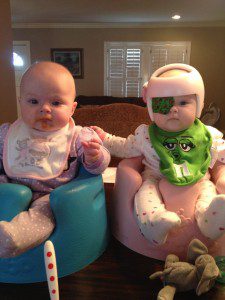This is my first post for Alamo City Moms Blog, and I’ll admit I was a little bit overwhelmed by the ideas floating around in my head. On my own blog, I usually just write about the daily happenings in my family, but my posts are usually lighthearted and about the unusual things that happen to a family of five. As an ACMB contributor, I feel like I need to step up my game. I went around and around with ideas, but decided to settle down and just write about what I am living with right now: kids with bad eyes.
There isn’t a mother out there who wants anything to be wrong with her kids. We all want our kids to be perfect—physically, emotionally, and behaviorally, preferably all the time. But let’s face it: perfection is never going to happen. For the purposes of this post, I am going to tell you about our recent experiences, provide some information about what to look for in kids’ eyes, and what action items you can take now to help your little one if you suspect something is wrong with your child’s vision.
We found out at our four-month well visit to the pediatrician that one of our identical twins has an eye issue. At our doctor’s office, they use a machine that scans infants’ and children’s eyes to check for possible vision problems. While this machine can give some kids with perfectly healthy eyes a false positive, I have first-hand knowledge that it can help you address an issue before it gets out of hand. Sweet Twinkie A, who was also being fitted for a helmet at the time for a squished head, had to go to the eye doctor for her first eye exam based on this simple screening.
When we arrived at the eye doctor, both of her eyes had to be dilated and she had to do a vision test. They also tested her for eye control and binocularity. The worst part was waiting 45 minutes for the dilation to take effect. We got the bad news that Twinkie A has a condition called strabismus. The good news is that the strabismus was not caused by vision issues.
My first question was: What’s a strabismus? Is it a lazy eye? Our wonderful CO (Certified Orthoptist) was nice and patient and explained things to me in simple terms which I will most likely mess up here, but I have included her info below so she can help any of you. She told us that first of all, lazy eye is a yucky term, but at least people know what it is. And no, what my daughter has is not a traditional lazy eye. A lazy eye is caused by a condition called amblyopia, where a person does not have good control of one eye, but the lack of control is caused by a big difference in the vision (e.g., one eye is 20/20, and the other is 20/100). A strabismus is a condition where one eye has weak muscles and therefore a person has to work really hard to keep her eyes in sync.
Then came my ah-ha moment: I have this! I can make myself have double vision and sometimes my eyes just do it when I am tired and, cough cough, somewhat intoxicated.
Sheesh. Not only did we receive this news, but I gave this condition to my children. Cue the guilt trip. I recovered and learned that we would have to start patching our little warrior (she’s a warrior because she had an eye patch and a helmet, bless her heart).

We patched two hours a day on and off for a year-and-a-half with follow-up visits about every two months. When she was patching, her eye control was great. When she was off patching, her eye control wasn’t great.

At the girls’ 18-month visit, we got the worst news yet: Twinkie B was also starting to have eye control problems. So we started patching her and gave Twinkie A a break. I quickly learned that patching a four-month-old is VERY different from patching an 18-month-old. Four-month-olds can’t rip off their own patches. Eighteen-month-olds can. Great.
Fast forward to the present, and since we caught Twinkie B’s later AND because the patching wasn’t showing signs of really helping either of them gain good control, both of my girls go in for surgery the first week in July. It was a horribly painful decision, and I cried when we left the doctor’s office, but I know it is the right plan for them.
By now you are probably thinking: What on earth does this story have to do with me? Or you might be panicking. Or you might know someone who has a new baby whose eyes go all over the place. Or you might be in a situation I have not thought of, which is why I called Claire Hennessey, C.O., who cares for my girls along with Dr. Charles McCash at the Children’s Eye Center of South Texas, for me to get a few takeaways for this post. Here are a few facts and good things to know for your kids’ vision:
- Vision in children should be 20/20 and totally straight by six months of age.
- Kids should learn to link their eyes together and have binocularity within the first six months.
- If you have a family history of amblyopia, strabismus, or other eye issues, you should get your child’s eyes checked within the first year of life.
- Eyes subscribe to the “if you don’t use it, you lose it” phenomenon. This means that if your child starts using just one eye, the other eye will shut down. Amblyopia is the number one cause of vision loss in children.
- The first decade of life is a critical period for vision development. Vision issues are often treatable before a child is 10 years old.
- Getting any child’s vision checked by a pediatric ophthalmologist (an eye doctor who specializes in children) before age two and a half is a good idea.
- School and pediatrician screenings catch many, many vision issues, so nine times out of 10 if you child is passing these, you have nothing to worry about.
I hope our story gives someone out there a plan for getting their kids’ eyes checked, and if not that, hopefully at least someone thinks the Twinkies look darn cute in their matching eye patches. Wish us luck in July because we are going to have to apply antibiotic cream to both girls’ eyes twice a day for a week…that should be fun!












My daughter is in this same boat. Was squished in the womb, wore the cutest cheetah print helmet, and has one eye that goes up when she looks to the left. Pediatric ophthomologist said that patcching wont work, and said we can choose surgery to fix the muscles, but that it wasnt neccisary until kindergarten or first grade. He was not concerned about vision, and implied that his was purey for the social aspect…meaning so he other kids wouldnt make fun of her. He was not sure that it would correct it completely, so I am looking for a second opinion. This article and the comments helped me to realize that patching is not the answer. Im curious to know how your girls did with the surgery…and if you would recommend it at this age. My daughter just turned 2.
My daughter had this condition as well. I noticed her eye moving outward at 2 yrs but her vision never seemed to bother her so I guess I didnt panic about it. We did surgery when she was 4. Dr said we could opt for the eye patches but, ultimately, the only thing that would fix it would be surgery. I was a wreck, obviously, but we were home from the hospital by lunch time and her eyes were immediately corrected. Her Dr said this issue can reoccur over time (his wife had personally had the surgery 4 times in her life).
My son has this as well, part of a list of things he was born with including cerebral palsy. We saw a doctor when he was a year which is when we really started to notice his eyes were’t ‘setting’ normally. The first doctor we saw had us to patching and we followed through, went back for the appointment and we were told that patching didn’t work and that my son would have to have surgery and wanted to schedule right then and there. I wanted a second opinion. I wanted to exhaust all options before putting my child, who has a clotting and platelet issue, under the knife for something with those 2 issues would cause a very long healing time and for it to be on his face. At the beginning of the year we started therapies with my son, PT/OT/ST, and we were required to have follow ups and check ups with different doctors, vision being one of them. I found McCash and he gives me what I want to hear and I know exactly how to not be yanked around anymore by doctors and how easy it is to go find someone else for another opinion. McCash told us that the patch we did for my son made the issue from eye we patched just switch to the other eye. Patching was not to right thing to do in the first place. My son now has been wearing glasses for a few months now and his vision is where the doctor likes to see it. The glasses won’t always help and we still have surgery on the table as a last resort.
I am glad to see other moms out there that have struggles similar to mine. It helps to accept the plan that God has made for me and my family. Thank you for sharing about your girls. They are adorable.
Hi there! My son also was diagnosed with strabismus a month before he turned two years old. Our doctor told us straight away that patching the eye would not solve the problem and that his deficit (or whatever the term is) wasn’t great enough to require surgery (where your girls apparently is). Our doctor is a bit old-school, quite dull, and his office building is stuck in the 70’s, circa Three’s Company. BUT he is very knowledgeable, has had his research published, and takes his time. He is a pediatric ophthalmologist on the edge of downtown, Dr. James L Mims III. I highly recommend him. My son was placed in glasses to help both of his eyes focus onto the same thing as to not have double vision, and he has shown great improvement over the years. I’m sorry the patching didn’t work for your girls and that you had to endure that. I had almost hoped that surgery was an option for my son because the doctor said there was a great chance that once he had surgery he would most likely not beed glasses anymore! I pray their surgeries go well!
Thank you so much for writing this! My little guy has the vision part of the eye issues so that means there is no fix for him other than glasses (which he totally rocks and makes him even cuter!) But it is scary to hear that our babies eyes are not working properly! We go to Dr. Mims but have heard nothing but great things about McCash and successful surgeries. I too cried thinking my baby would have to have eye surgery and then cried again when we found out that wouldn’t correct the problem. The positive is that his eyes will always be protected by glasses. His.Whole.Life. We are praying for a miracle that his eyes will fix themselves before he is 10! Bless you and I will be thinking of you and your girls in July!